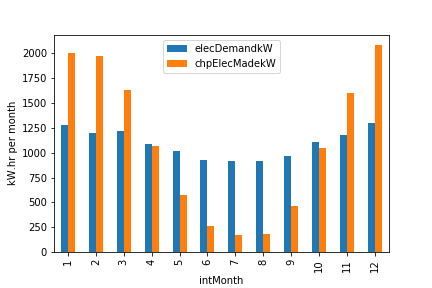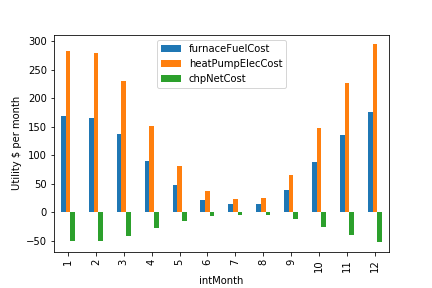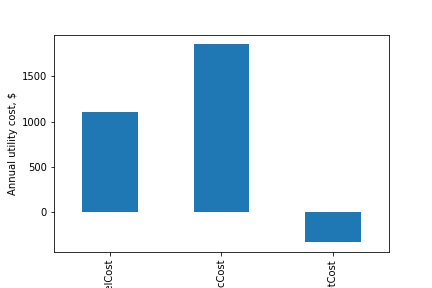Introduction
One of my previous articles https://kevindorma.ca/2021/10/09/evaluation-of-an-air-source-heat-pump-in-calgary/ looked at the effectiveness of a Cold Climate Air Source Heat Pump (CCASHP) for heating a home in Calgary. Since Alberta derives most of it’s electricity from gas turbine power plants, I assumed that the additional electricity would be produced by a Combined Cycle Gas Turbine (CCGT). Both the amount of CO2 emitted by the additional load on the CCGT and the annual cost was compared to the traditional way of heating a home: a high efficiency natural gas furnace.
The conclusion from the analysis was that the electrical expense for the CCASHP would be higher than the cost of natural gas in a furnace. This was not surprising. However, the net CO2 emissions caused by the additional load on the CCGT power supply would be lower than the emissions from the natural gas furnace. This was surprising.
Objective
In this article, we go in a different direction. We will examine the effectiveness of a micro Combined Heat and Power (CHP) facility to heat ones home, and compare with the cost and net CO2 emissions from the natural gas furnace and CCASHP that consumes power generated by a CCGT.
A CHP system is operated with the primary objective of recovering waste heat to keep your house warm. Electricity is produced as a valuable byproduct. This allows a CHP unit to extract more value from natural gas, compared to a gas furnace. This is the exact oppositie of a gas turbine power plant, where the objective is to produce power, and none of the waste heat is utilized.
For the CHP system, performance data for the 6 kW XRGI-6 (EC Power, from Denmark) [1] is used.
- the electrical efficiency is 30.1% (LHV basis)
- waste heat recovery efficiency is 72.3% (LHV basis).
This is a fairly large unit, about the same size as stove or washing machine and quite heavy at 440 kg. This would be located outside ones home.
For net metering in Alberta, we will compare the amount of electricity produced by the CHP device to the amount of electricity that my home consumes for a typical winter. For the generated electricity that backs out my demand from the grid, we will apply the net electrical cost of $0.14 per kW.hr. For surplus electricity for the month, it is assumed that the electricity is pushed to the grid and we get nothing in return.
The same data sources are used in this analysis:
- the utility bills for my home are correlated with monthly ambient temperature to construct a simple model for heat demand and electrical demand as a function of ambient temperature.
- 12 years of hourly ambient temperature data are used to provide a decent statistical view of the typical ambient temperature in Calgary.
- the performance data for a research-based CCASHP is used to determine the COP as a function of temperature [2].
The Jupyter code is available at the end of this article. A PDF printout is included for those not conversant in Python but want to follow along with the formulas to check the consistency of the work.
Ambient temperature
First we will look at the amount of energy needed to keep our house warm, and which temperature consumes the majority of the heat.

The coldest five winter months are November through March. Both heat demand and electrical demand are highest for these months. February has a curious dip in electrical demand: this is because February has only 28 days where the other winter months have 30 or 31
Analysis
Our CHP unit will make the most power in the coldest months.

During the coldest months of the winter (November – March) the CHP unit produces about 45% more power than is consumed. Displacing our electric bill is worth about $ 0.14 per kW.hr till we back out all of the consumption. I am assuming that we get zero value from the Utility company for surplus electricity that we produce, and this is consumed by our neighbour.

In the previous post we saw the surprising result with the net CO2 emissions from a CCASHPT in Calgary. Even though Alberta produces electricity by burning natural gas (with a CCGT), the heat pump has about 30% lower emissions than the natural gas furnace. This was a pleasant surprise.
But the micro CHP unit goes a large step further. Since the CHP unit produces power and backs out the CCGT, the CHP unit results in about 40% lower CO2 emissions than the gas furnace. This is considerably better than the air source heat pump.
The low winter temperatures in Calgary are a valuable asset.

Over a year, the CHP unit has about 45% lower CO2 emissions compared with a furnace, and about 15% lower CO2 emissions than a heat pump.
Let’s compare utility costs.


Hang on. Why is the utility cost negative for the micro CHP unit?
Reflection
From the last post, we saw that a heat pump costs about 40% more to operate than a gas furnace. We could argue that is the cost that an environmentally conscious person needs to bear. A CHP unit, on the other hand, produces electricity. The generated electricity is valued at only $0.035 per kW.hr (the fuel cost of natural gas). And we backed out electricity valued at $0.14 per kW.hr.
Our little CHP unit has a significant impact on the utility expense for the home.
Summary
We can be environmentally conscious and save money. All it takes is an investment into a CHP unit to heat your home instead of the traditional gas furnace.
Keep in mind that this analysis assumes the worst case: surplus electricity is pushed to the grid and we get no compensation for it.
Suppose we had a system for purchasing surplus renewable power from micro producers. Then people with CHP units could recover more value from their surplus renewable power, and others could benefit from purchasing this energy. This would provide even greater incentive for conserving our resources.
What could you do with a winter supply of low cost, renewable electrical power? Operate grow lights for a small greenhouse or a cannabis operation? Mine Bitcoin? This excess supply is only available for 4 – 5 months per year, and depends on whether we have a brutal cold snap. But if your demand can take advantage of an opportunistic supply, or you have the greatest demand in the winter, then this could help your business.
All we need is for people in Alberta to change our ideas about how we heat our homes.
References
- https://www.ecpower.eu/en/xrgi-systems.html
- Tom Marsik and others, Air Source Heat Pumps in Cold Climates, NREL, CCHRC (slide 9) (2018)







